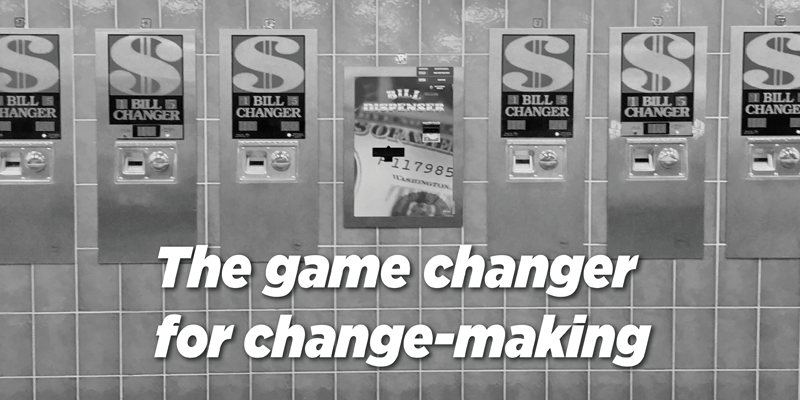The game changer for change-making

Changers are incredible technological marvels. They’re by far the laundromat’s easiest and most user-friendly machinery.
Change-making works without any guidance, registration or prompts. People from all walks of life just slip cash in and take it out. Mess up and you’ll get plenty of retries.
But changers are also the only machines in the house that don’t make money. Bill-to-coin conversion is a zero sum game.
Coin-op owners invest in state-of-the-art change equipment and load it up with cash knowing full well they’ll never generate a single penny of profit. To add insult to injury, neighboring residents and shopkeepers drain the darn things when the owner’s back is turned.
Talk about a thankless service. The changer truly is the Rodney Dangerfield of the laundromat business. It “don’t get no respect.”
Few appreciate the changer’s versatility beyond coin dispensing. In fact, it’s self-service laundry’s original kiosk where cash meets cashless and customer loyalty builds with every transaction.
Change gets cranking
Circulation of coinage is as vital to laundry as the flow of gas, electric and water. Jim McNutt, Sr. recognized this back in the 1950s when he developed Standard Change-makers’ first coin-to-coin conversion units.
His manually-operated devices cranked out lower denomination coins from higher ones, providing customers a ready supply of quarters, dimes and nickels for use at washers, dryers and venders. McNutt’s innovations played a pivotal role in the rapid expansion of the unattended store format.
Electronic dollar bill changers debuted in the 1960s with vertical coin tube magazines punching out a popular blend of three quarters, two dimes and one nickel.
Dual $1/$5 changers arrived on the scene in the ’70s, coinciding with laundry’s shift to all quarters. The following decade, four-bill $1-$20 acceptance hit the market and immediately embraced by operators who were quickly gearing up with high-priced front loaders.
Bills went big, but coins stayed small. Unlike other self-service sectors, laundromat changers hit pause at twenty-five cents. Most coin-ops today dispense 80 quarters for a twenty just like they did 35 years ago.
If that heaping handful sounds extreme, imagine what families spending $60 or more on wash day have to juggle. Quarter-only burdens customers from the get-go with a high volume of low denomination coins.
Owners also feel the impact as…
* Large amounts of cash are tied up in hopper inventory
* Additional high-capacity changers may be needed
* Cash hopper stock poses an attractive target for thieves
* Quarter-only payouts lure non-patrons
Thankfully, there’s a proven remedy. It starts right there at the changer by employing the laundromat’s most underrated coinage — dollar tokens.
Big golden brass has emerged as a crowd favorite in laundry, combining the utility of the higher-denomination dollar coin and the appeal of cashless pay.
Built-in flexibility
More and more laundromat owners are upsizing what they circulate by tweaking changers and fitting machines with coin/token-specific drops. Some dispense dollar tokens for redemption at whole dollar-priced washers and dryers, while others pay out blends with quarter coins or quarter-value tokens to better facilitate small incremental vend pricing.
Flexibility is key. Changers, washers and dryers have long had the capability to handle dual coinage. Customized drops work hand-in-glove with machinery to process both dollar- and quarter-valued tokens and coins.
Reviving dead money
Forget those so-called zombie mats. Let’s focus instead on lively laundromats and their dead money.
Coin-ops may be great investments, but the quarters housed inside their changers don’t yield a return. The initial coin inventory totaling hundreds — or more likely thousands — of dollars gets continually replenished and sits locked away. Why not revive that dead cash by putting it to work?
Consider this: A hopper with 4,000 quarters represents $1,000 in dead money. An even swap for 4,000 dollar tokens at 25¢ apiece quadruples the inventory’s transactional value.
Banking high denomination brass means a cashless stockpile and organic hopper capacity growth, freeing up working capital and eliminating the need for more changers.
Generating a buzz
Dollar tokens unlock automated promotions to build loyalty, including “big bill bonuses” and “double your money” — two specials typically associated with more cost-intensive card systems.
If offering two bonus dollar tokens for a $20 bill stimulates sales, imagine the buzz generated by a limited time promo doubling normal payouts to 40 tokens for 20 bucks; 20-for-10; 10-for-5 and 2-for-1. How’s that for competing with card stores?
Mounting a credit card-to-token reader at the changer opens a new revenue gateway by appealing to non-cash patrons and bringing them into the fold on promotional offers.
Speaking of profitability, the math for walkaway dollar tokens is straightforward. Every single one that leaves and doesn’t return puts the owner up about 75¢.
The sound of brass
Cashless coinage inside changers repels burglars as well as neighborhood quick change artists. The sight and sound of brass isn’t music to their ears.
Refunds? No problem. Making a patron whole for an occasional payout malfunction is handled with house currency, not cash.
The dollar token is the game changer for laundromat change-making. You can bank on that.

Laurance Cohen is part of the Imonex team and welcomes inquiries on innovative payment solutions for your business.
laurance@imonex.com
(954) 999-7785

